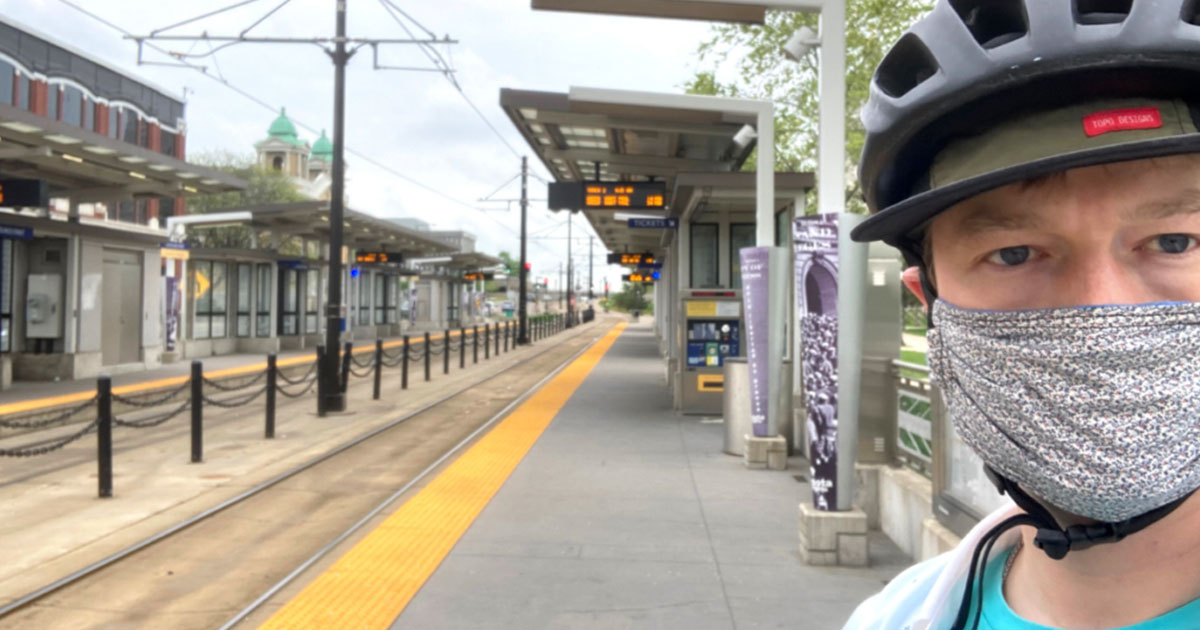What We Know About Transit and COVID-19
What do we know about transit these days? What should individuals and transit agencies be doing to make riding as safe as possible? What actions have Metro Transit taken? Move Minnesota is taking a closer look at what you need to know about transit in the time of COVID-19. We have gathered public information to help you make the right transit decisions for you and your family.
We sat down with essential worker, Claire Thomas of Minneapolis, to hear what it’s like to ride transit at this time:
“I don’t own a car so I walk and/or bus for groceries. I mostly work from home now, but I still go into the office at least two days per week. There are in-person components of my job that can’t be done from home. I live in uptown Minneapolis and commute to downtown Saint Paul for work. Before COVID-19, I took the 53 bus, but now I have to take the 21 bus because the 53 route was suspended when Metro Transit reduced service by 40%.
I was prepared for the mask mandate on buses – I always have a couple masks in my purse now anyways. It’s strange to remember early in the pandemic when no one had masks and we were on these crowded buses. Now most people wear masks, and some drivers really hold people to it.
People try to social distance on the bus, but sometimes the buses can fill up and the driver stops letting people on. People trying to board in the middle of the route, like East Lake Street, may not be able to board. It’s not like buses are running very frequently either. So if someone needs to make an essential trip and the bus can’t fit any more riders, that person gets really inconvenienced. I think they started running more buses along that section in recent weeks.
For months the buses weren’t collecting fare because of COVID-19 precautions. Not collecting fares made riding transit easy and simple. We were able to board through the back door to make it safer for the driver. Riders didn’t have to worry about having the correct change, and people were able to board faster so the bus could stay on schedule.” Metro Transit has since returned to collecting fare and boarding through the front door.
Although information about transit use and COVID-19 continues to develop, COVID has now been with us long enough to reveal best practices and produce data. In addition to rider descriptions of their experiences, here is what we know today:
Safety on Transit
Data show that transit has not been disproportionately linked to coronavirus spread. There have been few to no COVID clusters attributable to transit use in high transit use cities, including Paris, Tokyo, and Hong Kong. In a survey conducted by the New York Times, experts suggested taking transit was likely riskier that walking outdoors but safer than indoor dining.
From a population health standpoint, high transit use over time improves health outcomes because high transit ridership lowers total particulate emissions. Heightened particulate emissions in a community are associated with increased death rates from COVID-19.
Staying Safe as an Individual
Staying safe on public transit is similar to staying safe in all enclosed public spaces, whether a grocery store, café, or pharmacy:
- People who are symptomatic or who have had contact with someone who is should avoid using public transit.
- Wear a mask, and, if possible, space out from others. However, a survey of transit reliant cities around the world shows that mask wearing is far more important that physical spacing.
- Be aware of high-touch surfaces (hand rails, poles) and wash or sanitize hands after contact with these surfaces.
Keeping Buses and Trains Healthy Environments
Again, maintaining a healthy environment on transit vehicles largely mirrors health and safety best practices for all public spaces (to see what Metro Transit is doing, visit their Health page):
- Provide hand sanitizer in multiple places on the transit vehicle.
- Maintain a physical separation between the driver and passengers, with a barrier if possible.
- Ventilate buses and trains well, including with open windows, and use HEPA filters in the ventilation systems.
- Clean and sanitize transit vehicles regularly.
- If possible, provide real time vehicle crowding information via an app or website to allow riders to plan trips in the safest way possible, as in Boston.
In addition, it is important to note that improving transit service results in a healthier trip. First, more frequent arrivals mean riders are spread out between a greater number of vehicles—and it allows everyone to get where they need to go when they need to get there, unlike the scenario Claire described in which people in the middle of a route sometimes end up without a boardable bus. Second, faster travel speeds mean less time in an enclosed space. So while transit appears as safe or safer than many other public indoor spaces in terms of COVID-19 spread, it can be made safer in ways that improve the long-term functioning of the system.

